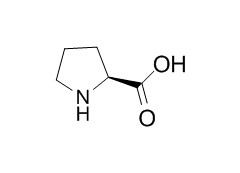Proline
L-Proline is one of the twenty amino acids used in living organisms as the building blocks of proteins.Proline accumulates in many plant species in response to environmental stress, it can act as a signaling molecule to modulate mitochondrial functions, influence cell proliferation or cell death and trigger specific gene expression, which can be essential for plant recovery from stress, the engineering of proline metabolism could lead to new opportunities to improve plant tolerance of environmental stresses.
Inquire / Order:
manager@chemfaces.com
Technical Inquiries:
service@chemfaces.com
Tel:
+86-27-84237783
Fax:
+86-27-84254680
Address:
1 Building, No. 83, CheCheng Rd., Wuhan Economic and Technological Development Zone, Wuhan, Hubei 430056, PRC
Providing storage is as stated on the product vial and the vial is kept tightly sealed, the product can be stored for up to
24 months(2-8C).
Wherever possible, you should prepare and use solutions on the same day. However, if you need to make up stock solutions in advance, we recommend that you store the solution as aliquots in tightly sealed vials at -20C. Generally, these will be useable for up to two weeks. Before use, and prior to opening the vial we recommend that you allow your product to equilibrate to room temperature for at least 1 hour.
Need more advice on solubility, usage and handling? Please email to: service@chemfaces.com
The packaging of the product may have turned upside down during transportation, resulting in the natural compounds adhering to the neck or cap of the vial. take the vial out of its packaging and gently shake to let the compounds fall to the bottom of the vial. for liquid products, centrifuge at 200-500 RPM to gather the liquid at the bottom of the vial. try to avoid loss or contamination during handling.
J Ginseng Res.2023, 47(4):572-582.
Evid Based Complement Alternat Med.2021, 2021:5319584.
Molecules.2020, 25(23):5636.
Journal of Medicinal Food2023, Vol.26(10).
Sci Rep.2019, 9(1):18080
Int J Mol Sci.2020, 21(19):7209.
Pharm Biol.2022, 60(1):2040-2048.
FEMS Microbiol Lett.2017, 364(11)
Molecules 2022, 27(3),960.
Food Quality and Safety2018, 2:213-219
Related and Featured Products
Science. 2001 Apr 20;292(5516):464-8.
HIFalpha targeted for VHL-mediated destruction by proline hydroxylation: implications for O2 sensing.[Pubmed:
11292862 ]
HIF (hypoxia-inducible factor) is a transcription factor that plays a pivotal role in cellular adaptation to changes in oxygen availability. In the presence of oxygen, HIF is targeted for destruction by an E3 ubiquitin ligase containing the von Hippel-Lindau tumor suppressor protein (pVHL). We found that human pVHL binds to a short HIF-derived peptide when a conserved Proline residue at the core of this peptide is hydroxylated. Because Proline hydroxylation requires molecular oxygen and Fe(2+), this protein modification may play a key role in mammalian oxygen sensing.
Trends Plant Sci. 2010 Feb;15(2):89-97.
Proline: a multifunctional amino acid.[Pubmed:
20036181 ]
Proline accumulates in many plant species in response to environmental stress. Although much is now known about Proline metabolism, some aspects of its biological functions are still unclear. Here, we discuss the compartmentalization of Proline biosynthesis, accumulation and degradation in the cytosol, chloroplast and mitochondria. We also describe the role of Proline in cellular homeostasis, including redox balance and energy status. Proline can act as a signaling molecule to modulate mitochondrial functions, influence cell proliferation or cell death and trigger specific gene expression, which can be essential for plant recovery from stress. Although the regulation and function of Proline accumulation are not yet completely understood, the engineering of Proline metabolism could lead to new opportunities to improve plant tolerance of environmental stresses.
Cell. 2006 Sep 8;126(5):905-16.
Proline isomerization of histone H3 regulates lysine methylation and gene expression.[Pubmed:
16959570 ]
The cis-trans isomerization of Proline serves as a regulatory switch in signaling pathways. We identify the Proline isomerase Fpr4, a member of the FK506 binding protein family in Saccharomyces cerevisiae, as an enzyme which binds the amino-terminal tail of histones H3 and H4 and catalyses the isomerization of H3 Proline P30 and P38 in vitro. We show that P38 is necessary for methylation of K36 and that isomerization by Fpr4 inhibits the ability of Set2 to methylate H3 K36 in vitro. These results suggest that the conformational state of P38, controlled by Fpr4, is important for methylation of H3K36 by Set2. Consistent with such an antagonistic role, abrogation of Fpr4 catalytic activity in vivo results in increased levels of H3K36 methylation and delayed transcriptional induction kinetics of specific genes in yeast. These results identify Proline isomerization as a novel noncovalent histone modification that regulates transcription and provides evidence for crosstalk between histone lysine methylation and Proline isomerization.



